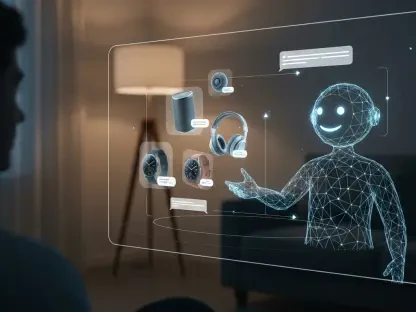The transformation underway within the field of digital engineering encompasses numerous progressively emergent trends, such as AI-driven solutions, digital twin applications, and cloud-based engineering. These trends, expected to be dominant in 2025, are not only pioneering innovations but also thoroughly overhauling traditional engineering practices, offering unprecedented prospects for design efficiencies, operational excellence, and overall sustainability across a multitude of sectors including manufacturing, aerospace, and automotive. This narrative will explore these trends in-depth, consolidate the information into a cohesive and comprehensive overview, and eliminate redundant points while emphasizing the innovative nature and potential impact of these technologies.
Generative AI: Revolutionizing Design Parameters
Generative AI sits at the forefront of the digital engineering revolution, heralding a new era where engineering design parameters are significantly enhanced. This transformative AI technology employs advanced algorithms to process and analyze vast datasets, subsequently generating optimized design solutions. Generative AI’s influence is particularly profound in industries necessitating the integration of complex engineering constraints and multiple design iterations, such as aerospace, automotive, and architectural engineering.
With its ability to handle varied variables simultaneously, generative AI drastically reduces design cycle times while optimizing resource allocation and increasing efficiency in solutions. By leveraging AI, engineers are afforded the opportunity to explore a broader range of design possibilities, leading to innovative outcomes that were previously unattainable. As organizations continue to integrate this AI-driven approach, the potential for groundbreaking advancements and efficiencies within engineering projects becomes increasingly evident.
Immersive Technologies: AR and VR in Engineering
Augmented Reality (AR) and Virtual Reality (VR) technologies are rapidly reshaping the engineering landscape, creating immersive environments that fundamentally alter traditional workflows. Projections indicate that the market for AR and VR technologies is set to surge from $30 billion in 2022 to over $520 billion by 2031, highlighting their growing significance in engineering. These technologies are especially instrumental in dealing with complex engineering projects that require a high degree of spatial awareness and real-time collaboration.
AR and VR are revolutionizing design validation and project execution. They allow engineers to visualize intricate systems and conduct virtual walkthroughs before physical construction begins. This capability ensures early detection of potential design flaws, leading to substantial cost savings across industries such as manufacturing. Furthermore, AR and VR enable real-time collaboration, breaking down geographical barriers and allowing for seamless teamwork, thereby enhancing the efficiency and accuracy of engineering projects.
Blockchain: Enhancing Data Security and Integrity
Within the realm of digital engineering, blockchain technology has emerged as a key player in ensuring data security and integrity. Blockchain’s capability to create immutable records enhances the reliability and traceability of data, which is particularly crucial for managing complex engineering projects. The forecasted growth of the blockchain market from $26.91 billion in 2024 to an estimated $1.87 trillion by 2034 underscores its rising adoption and significance in the sector.
By offering improved intellectual property protection, supply chain management, and transparent documentation, blockchain facilitates secure collaboration and efficient management of digital assets. This technology’s role in fortifying data security is becoming increasingly vital, especially as engineering projects become more digitized and interconnected. As blockchain continues to be integrated into digital engineering practices, its capacity to safeguard data and enhance project management processes will undoubtedly become more pronounced.
Hyper-Personalization: Tailoring Engineering Solutions
Hyper-personalization, powered by advanced analytics and machine learning, is ushering in a new era of precisely tailored engineering solutions that meet unique client requirements. The hyper-personalized AI market is projected to reach $50 billion by 2025, reflecting the growing demand for customized engineering solutions. This capability drives not only innovation but also client satisfaction, with companies reporting a 77% increase in market share due to hyper-personalized offerings.
In the context of smart engineering practices, hyper-personalization advances the focus on optimized, user-specific solutions. By leveraging data and machine learning techniques, engineers can develop highly customized designs that cater to the distinct needs of individual clients. This not only enhances the overall value and effectiveness of engineering projects but also fosters stronger client relationships, as tailored solutions are more likely to meet and exceed expectations.
No-Code and Low-Code Platforms: Democratizing Development
No-code and low-code platforms have significantly democratized the development of engineering solutions, enabling rapid creation and deployment with minimal coding efforts. These platforms are expected to reach a market value of $64.95 billion by 2032, affirming their revolutionary impact on the engineering field. The potential of these platforms to automate routine development tasks provides engineers with more time to focus on complex problem-solving activities and accelerates digital transformation initiatives.
The anticipated exponential growth to $86.9 billion by 2027 underscores the integral role of no-code and low-code platforms in modern engineering. By simplifying the development process, these platforms empower a broader range of professionals to contribute to engineering projects. This democratization fosters a culture of innovation and efficiency, making advanced engineering solutions more accessible and promoting collaboration across diverse teams.
Cloud-Native Technologies: Enabling Scalability and Flexibility
Cloud-native technologies are pivotal in offering scalability and flexibility, which are essential for comprehensive digital transformation strategies in digital engineering. With the global cloud computing market projected to grow to $2,974.6 billion by 2033, the significance of cloud-native solutions is undeniable. These technologies facilitate agile development and deployment, ensuring robust performance and dynamic scalability, particularly in the automation of engineering design.
The increasing adoption of hybrid and multi-cloud strategies highlights the maturity and importance of cloud-native engineering practices. Such technologies provide the necessary infrastructure to support complex engineering projects, enabling seamless collaboration and efficient resource management. As organizations continue to embrace cloud-native solutions, the ability to scale operations and adapt to changing demands will become a cornerstone of successful engineering endeavors.
IoT Integration: Driving Innovation and Efficiency
The proliferation of Internet of Things (IoT) devices is creating interconnected systems that generate valuable data, driving innovation in engineering design and enhancing operational efficiency. With IoT devices set to exceed $27 billion by 2025 and the potential economic value estimated between $4-11 trillion, the integration of IoT technologies is becoming increasingly critical. IoT allows for real-time monitoring, predictive maintenance, and optimized resource utilization, thereby transforming traditional engineering practices.
IoT integration facilitates informed decision-making through the continuous collection and analysis of data. This real-time insight enables engineers to enhance operational outcomes, improve efficiency, and reduce downtime. As more industries adopt IoT technologies, the ability to harness this data for innovative engineering solutions will become a key differentiator in achieving operational excellence and maintaining a competitive edge.
Neurological Enhancement: Elevating Cognitive Performance
Neurological enhancement technologies, through advanced human-machine interfaces like bidirectional brain-machine interfaces (BBMIs), are transforming engineering tasks that require elevated cognitive performance and precise control. By 2030, it is estimated that 30% of knowledge workers will utilize such technologies, a significant increase from less than 1% in 2024. Companies such as Neuralink are at the forefront of developing sophisticated neural interfaces that promise to revolutionize engineers’ interactions with design software and control systems.
These advancements hold the potential to significantly enhance cognitive capabilities, allowing engineers to perform tasks with greater precision and efficiency. However, it is equally important to address the ethical considerations associated with implementing such technologies. As neurological enhancement becomes more prevalent, the balance between leveraging these advancements and ensuring ethical integrity will be crucial.
Polyfunctional Robots: Enhancing Industrial Engineering
Polyfunctional robots are driving significant advancements in industrial engineering, offering the ability to perform a wide array of tasks with precision and efficiency. These robots, equipped with advanced sensors and AI capabilities, are reshaping manufacturing processes by increasing productivity, reducing error rates, and enabling flexible automation. By 2025, the integration of polyfunctional robots across industries is expected to be a defining element in achieving operational excellence.
The use of polyfunctional robots in industrial engineering enhances capabilities in areas such as assembly, quality control, and logistics. Their adaptability to various tasks ensures that they can be seamlessly integrated into existing workflows, thereby optimizing performance and reducing downtime. As technology advances, the development and deployment of sophisticated robots will continue to drive innovation and efficiency in industrial engineering practices.
These trends highlight the innovative nature and substantial impact that digital engineering technologies are poised to have across industries by 2025. As these advancements pave the way for greater efficiency, operational excellence, and sustainability, they collectively represent a future where engineering practices are radically transformed.









